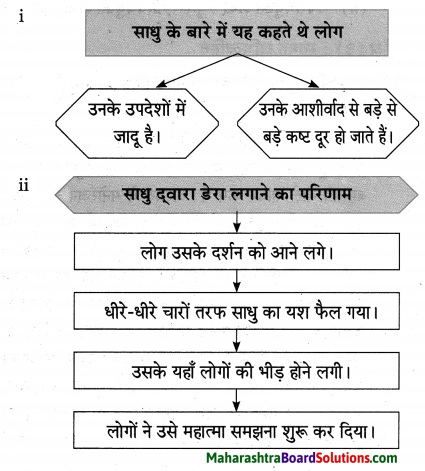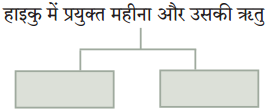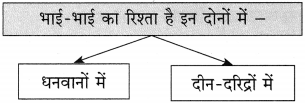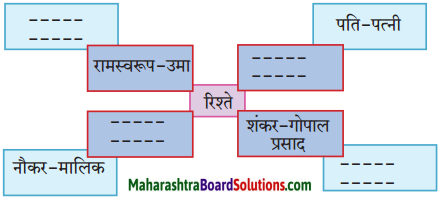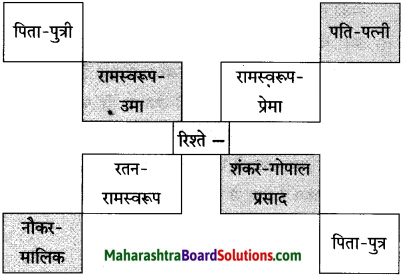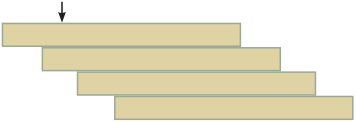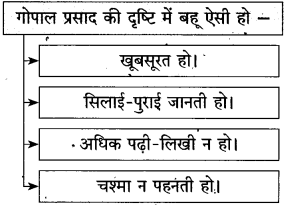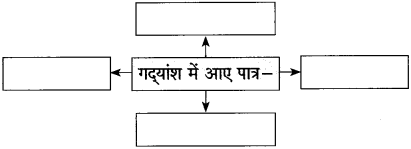Balbharti Maharashtra State Board Class 10 Hindi Solutions Lokvani Chapter 1 सोंधी सुगंध Notes, Textbook Exercise Important Questions and Answers.
Std 10 Hindi Chapter 1 Sondhi Sugandh Question Answer Maharashtra Board
Hindi Lokvani 10th Digest Chapter 1 सोंधी सुगंध Questions And Answers
Hindi Lokvani 10th Std Digest Chapter 1 सोंधी सुगंध Textbook Questions and Answers
सूचना के अनुसार कृतियाँ कीजिए
(१) कृति पूर्ण कीजिए:

Answer:

![]()
(२) कृति पूर्ण कीजिए:

Answer:

(३) गीत में प्रयुक्त क्रियारूप लिखिए:
बाग-बगीचे, ताल-तलैया …………
Answer:
मुसकाएँ
झूम-झूमकर मस्ती में तरु गीत ………..
Answer:
सुनाएँ
मधुमास आस-विश्वास ………..
Answer:
किया
धरती ने ………….
Answer:
बढ़ाता
(४) उपसर्ग-प्रत्यय लगाकर शब्द लिखिए :
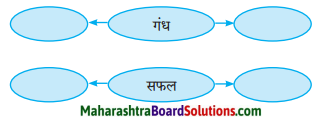
Answer:

अभिव्यक्ति
प्रस्तुत गीत की प्रथम चार पंक्तियों का भावार्थ लिखिए।
Answer:
वर्षा ऋतु के आगमन पर धरती पर बारिश की बूंदों का गिरना शुरू हो जाता है। बारिश की बूंदें धरती पर गिरकर मिट्टी को स्पर्श करती हैं, जिस कारण मिट्टी से सोंधी सुगंध आने लगती है। यह सोंधी सुगंध मिट्टी से बातें करने लगती हैं।
बारिश की बूंदों की अनुभूति से धरती प्रफुल्लित हो गई है। इसलिए जैसे ही बारिश थम जाती है; वैसे ही वह अपनी आँखें खोलती हैं। मोर को भी वर्षाऋत अत्यंत प्रिय है। अत: वह भी वर्षाऋत में खश होकर कह रहा है कि चारों ओर हरियाली ही हरियाली छा गई है। भीषण गरमी के कारण धरती बंजर हो गई थी। बादल बरसने के बाद हरियाली-सा हरा वस्त्र धारण करने का धरती का जो सपना था; वह अब वह पूरा हो गया है।
भाषा बिंदु
वर्तनी के अनुसार शुद्ध शब्द छाँटकर लिखिए:
- विश्वास/विशवास/विसवास ……..
- मसतक/मस्थक/मस्तक ……….
- पथ्थर/पथ्तर/पत्थर …………
- कुरीति/कूरिति/कुरिती …………
- चिन्ह/चीहन/चिह्न …………..
- इकठठा/इकट्टा/इकट्ठा ………….
- खुबसुरत/खूबसुरत/खूबसूरत …………
- विदयापीठ/विद्यापीठ/विद्यापिठ ………….
- बुद्धी/बुध्दी/बुद्धि ………….
- परिक्षार्थि/परीक्षार्थि/परीक्षार्थी ………….
Answer:
- विश्वास
- मस्तक
- पत्थर
- कुरीति
- चिह्न
- इकट्ठा
- खूबसूरत
- विद्यापीठ
- बुद्धि
- परीक्षार्थी
![]()
उपयोजित लेखन
निम्नलिखित सुवचन पर आधारित कहानी लिखिए:
‘स्वास्थ्य ही संपदा है।’
Answer:
श्रीरामपुर गाँव में धनसुखलाल नाम का एक धनी व्यक्ति रहता था। वह बहुत ही कंजूस प्रवृत्ति का था। रईस होने के बावजूद भी वह स्वयं पर कभी भी पैसे खर्च नहीं करता था। वह दिन में सिर्फ एक वक्त का भोजन करता था। इतना ही नहीं वह अपने परिवार वालों पर भी धन खर्च नहीं करता था। उसकी कंजूसी के कारण उसका परिवार प्रतिदिन भूखे पेट ही सोता था। एक दिन धनसुखलाल बीमार पड़ गया।
भरपेट खाना न खाने के कारण उसका शरीर कमजोर हो गया था। उसकी शक्ति कम हो गई थी। परिवार के लोग उसे डॉक्टर के पास ले जाना चाहते थे। लेकिन डॉक्टर के पास जाकर काफी रूपया खर्च हो जाएगा। इसलिए उसने घरेलू औषधियों लेना प्रारंभ कर दिया। आहिस्ता-आहिस्ता उसका शरीर अत्यधिक अस्वस्थ और कमजोर हो गया।
यहाँ तक कि अब उठकर चलने की शक्ति भी उसमें शेष नहीं थी। फिर भी वह डॉक्टर के पास जाने के लिए राजी नहीं हुआ। उसी शाम गाँव में एक महात्मा आए। उन्होंने धनसुखलाल के बारे में सुना और वे स्वयं उसे मिलने गए। महात्मा को देखकर धनसुखलाल ने सोचा कि यह महात्मा उसका इलाज कर देंगे। उसने आशा से महात्मा को प्रणाम किया। महात्मा ने उसे स्पष्ट कहा – ‘मूर्ख धनसुखलाल, मैं तुम्हारा भविष्य जानता हूँ। यदि तुम अभी डॉक्टर के पास नहीं जाओगे; तो कल सुबह तक तुम्हारी मृत्यु निश्चित है।’
महात्मा की भविष्यवाणी सुनकर धनसुखलाल के हाथ-पाँव काँपने लगे और महात्मा को प्रणाम करके वह तुरंत अपने परिवार वालों के साथ डॉक्टर के पास चला गया। डॉक्टर ने पूरी निष्ठा से उसका इलाज किया। कुछ दिनों के बाद वह ठीक हो गया। अब उसकी समझ में आ गया था कि ‘स्वास्थ्य ही संपदा होती है।’ सीख : स्वास्थ्य से बढ़कर दूसरी कोई संपत्ति नहीं होती। व्यक्ति को अपने स्वास्थ्य का सदैव ध्यान रखना चाहिए।
Hindi Lokvani 10th Std Textbook Solutions Chapter 1 सोंधी सुगंध Additional Important Questions and Answers
निम्नलिखित पद्यांश पढ़कर दी गई सूचनाओं के अनुसार कृतियाँ कीजिए।
कृति अ (१): आकलन कृति
कृति पूर्ण कीजिए।
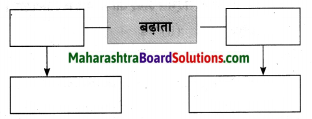
Answer:

समझकर लिखिए।

Answer:

![]()
‘सदियों का जो सपना है हो जाए पूरा।’ इससे आप समझते हैं
Answer:
भीषण गरमी के कारण धरती बंजर हो गई थी। अब बारिश के आने से वह फिर से हरी-भरी हो जाएगी।
कृति अ (२) : शब्द संपदा
निम्नलिखित शब्दों के अर्थ पद्यांश में से ढूँढ़कर लिखिए।
- मेघ
- मोर
- मृदा
- ख्वाब
Answer:
- बादल
- मयूरा
- माटी
- सपना
विलोम शब्द लिखिए।
- सुगंध x ……..
- पूरा x ………
Answer:
- सुगंध x दुर्गंध
- पूरा x अधूरा
वचन बदलिए।
- सदी
- हरियाली
- टोली
- आँखें
Answer:
- सदियाँ
- हरियालियाँ
- टोलियाँ
- आँख
निम्नलिखित तत्सम शब्द का तद्भव रूप लिखिए।
- मयूर
- हरित
Answer:
- मोर
- हरा या हरी
![]()
निम्नलिखित शब्द का देशज व तत्सम शब्द लिखिए।
Question 1.
मिट्टी
Answer:
देशज शब्द : माटी, तत्सम शब्द: मृदा
कृति अ (३) : स्वमत अभिव्यक्ति
आपने पहली बारिश के बाद चारों और महकने वाली मिट्टी की सुगंध को जरूर महसूस किया होगा। उस वक्त जो अनुभूति हुई थी, उसे अपने शब्दों में लिखिए।
Answer:
बारिश के पहले भीषण गरमी के कारण मिट्टी तपती है। जैसे ही वर्षा की पहली बूंदें धरती पर आती हैं, वैसे ही तपती हुई मिट्टी शीतलता का अनुभव करने लगती है। फिर उसमें से जो गंध उठती है, उसका क्या कहना? मिट्टी की सोंधी सुगंध सभी को आकर्षित करती है। मैं पिछले वर्ष बरसात शुरू होने से पहले अपने गाँव गया था। वहाँ पर मैंने पहली बरसात का अनुभव किया था। बारिश रुकते ही अचानक से सारा वातावरण मिट्टी की भीनी-भीनी सोंधी खुशबू से प्रफुल्लित हो उठा। मानो वह सोंधी महक मुझे बता रही थी कि हम सब उससे जुड़े हैं। हमारा शरीर भी उसी से बना है। आखिर मिट्टी हमें जीवन देती है। सचमुच मिट्टी की उस सोंधी महक ने मेरे चित्त को प्रसन्न कर दिया था। आज भी वह महक मेरे रोम-रोम में समाई हुई है। उस सोंधी महक को महसूस हुए मुझे मनुष्य और मिट्टी के बीच जो गहरा रिश्ता है इसका एहसास भी हुआ था।
संजाल पूर्ण कीजिए।

Answer:

कृति आ (२) : शब्द संपदा
‘रोली’ शब्द का अनेकार्थी शब्द लिखिए।
Answer:
सिंदूर, प्रसिद्ध भूमि, हल्दी व चूने का चूर्ण
निम्नलिखित तद्भव शब्द का तत्सम रूप लिखिए।
- माथा
- पेड़
Answer:
- मस्तक
- तरु
वचन बदलिए।
- बोली
- रोली
- झोली
- बगीचा
Answer:
- बोलियाँ
- रोलियाँ
- झोलियाँ
- बगीचे
![]()
कृति आ (३) : स्वमत अभिव्यक्ति
‘बारिश के बाद प्रकृति में होने वाला परिवर्तन’ विषय पर अपने विचार लिखिए।
Answer:
वर्षा ऋतु समस्त ऋतुओं की रानी है। बारिश होते ही चारों ओर हरियाली छा जाती है। वर्षा होने से तालाबों और नहरों में पानी भर जाता है। सागर अपनी मस्ती में लहरों के साथ नर्तन करता रहता है। वर्षा से सूखे पेड़-पौधों में भी जीवन आ जाता है। संपूर्ण वातावरण खुशनुमा हो जाता है। मिट्टी से सोंधी महक आनी शुरू हो जाती है। यह महक हमारे चित्त को प्रसन्न कर देती है। बारिश के बाद कृषकों में उल्लास बढ़ जाता है और वे अपने खेतों में लगन के साथ जुट जाते हैं। मोर प्रसन्न होकर नाचने लगते हैं और मेंढक टर्र-टर्र की आवाज करते रहते हैं। इस प्रकार बारिश के बाद प्रकृति की शोभा देखने लायक होती है।
समझकर लिखिए।

Answer:

निम्नलिखित पद्यांश पढ़कर दी गई सूचनाओं के अनुसार कृतियाँ कीजिए।
कृति इ (१): आकलन कृति
Question 1.
सदा-सदा से यह चली आई है –
Answer:
हँसी-ठिठोली
Question 2.
यह नतमस्तक हो गए हैं –
Answer:
कवि ‘अचूक’
निम्नलिखित शब्द पढ़कर ऐसे दो प्रश्न तैयार कीजिए कि जिनके उत्तर निम्न शब्द हों
Question 1.
माटी
Answer:
सोंधी-सौंधी-सी सुगंध किससे बात कर रही है?
Question 2.
मधुमास
Answer:
कवि ने पावस को किसकी उपमा दी है। (३) कृति पूर्ण कीजिए।
कृति इ (२) : शब्द संपदा
पद्यांश में से शब्द-युग्म ढूँढ़कर लिखिए।
Answer:
आस-विश्वास,
सदा-सदा,
हँसी-ठिठोली,
सोंधी-सौंधी-सी
निम्नलिखित तत्सम शब्द का तद्भव रूप लिखिए।
- पद
- मास
Answer:
- पाँव या पैर
- महीना
निम्नलिखित तद्भव शब्द का तत्सम रूप लिखिए।
- हँसी
Answer:
- हास्य
![]()
निम्नलिखित शब्दों के पर्यायवाची लिखिए।
- मधुमास
- पुष्प
- आस
- नत
Answer:
- वसंत ऋतु
- फूल
- आशा
- विनीत
कृति इ (३) : स्वमत अभिव्यक्ति
‘मनुष्य जीवन में वर्षा का महत्त्व’ इस विषय पर अपने विचार लिखिए।
Answer:
हमारा भारत देश कृषिप्रधान देश है। यदि बारिश समय पर न होगी, तो सूखा या दुर्भिक्ष (अकाल) की स्थिति निर्माण होने में देर नहीं लगेगी। वर्ष के बारह महीने में से तीन या चार महीनों तक लगातार बारिश होने के कारण प्रकृति का संतुलन बना रहता है। जल के बिना मनुष्य जीवन संभव नहीं। इसलिए हमारे जीवन में वर्षा का अत्यधिक महत्त्व है। वर्षा का मौसम तपती गरमी से राहत दिलाता है। बारिश की बूंदें धरती के बढ़े हुए तापमान को अपने अंदर समा लेती हैं। वर्षाकाल में लोग वर्षा का आनंद लेने के लिए पिकनिक मनाते हैं। वर्षा में सूखे हए तालाब, कुएँ और नदियाँ फिर से भर जाती हैं। इस कारण पूरे वर्ष तक मनुष्य को पीने के लिए पानी उपलब्ध होता है।
सोंधी सुगंध Summary in Hindi
सोंधी सुगंध कवि-परिचय
जीवन-परिचय : डॉ. कृपाशंकर शर्मा जी का जन्म उत्तर प्रदेश के एटा शहर में हुआ। हिंदी साहित्य में इन्हें ‘अचूक’ इस उपनाम से जाना
जाता है। इन्हें बालगीतकार एवं बालकहानीकार के रूप में अधिक जाना जाता है। इन्होंने कविता के विविध अंगों को सूक्ष्मता से जाना-पहचाना है। गीत, गजल, कविता एवं दोहे इनकी रचना का प्रमुख विषय रहे हैं। समीक्षा के क्षेत्र में भी इनका कार्य उल्लेखनीय हैं। पत्रकारिता के क्षेत्र में भी इनकी सक्रियता रही है।
प्रमुख कृतियाँ : ‘फिर भी कहना शेष रह गया’, ‘नदी उफान भरे’ (गीत संग्रह), ‘गीत खुशी के गाओ तुम’ (बालगीत संग्रह) आदि।
सोंधी सुगंध पद्य-परिचय
गीत : गीत हिंदी साहित्य की एक लोकप्रिय विधा है। स्वर, पद और ताल से युक्त जो गान होता है, वह ‘गीत’ कहलाता है। इसमें एक मुखड़ा तथा कुछ अंतरे होते हैं। प्रत्येक अंतरे के बाद मुखड़े को दोहराया जाता है। इसमें गेयता विद्यमान होती है।
प्रस्तावना : ‘सोंधी सुगंध’ इस गीत में कवि डॉ. कृपाशंकर शर्मा ‘अचूक’ जी ने वर्षा ऋतु का आगमन होने पर प्रकृति में छाई प्रसन्नता एवं खुशहाली का बड़ा ही सजीव एवं मनोहारी वर्णन किया है। वर्षा ऋतु में प्रकृति के विविध रूपों में होनेवाले परिवर्तन का अत्यंत आहलाददायी वर्णन प्रस्तुत कविता में किया गया है।
सोंधी सुगंध सारांश
प्रस्तुत कविता के माध्यम से स्पष्ट किया गया है कि प्रत्येक ऋतु का अपना महत्त्व और अपनी विशेषता है। भीषण गर्मी के कारण तापमान बढ़ता है। सभी भीषण गर्मी से व्याकुल हो जाते हैं। वर्षा तपती गर्मी से राहत दिलाती है। छम-छम करता हुआ पानी देख सबके चेहरे पर रौनक आ जाती है। पहली बारिश की बूंदें धरती को स्पर्श करती हैं, जिस कारण मिट्टी से सोंधी सुगंध आने लगती है। यह सोंधी सुगंध मिट्टी से बातें करने लगती हैं। वह वर्षा के कारण प्रकृति के विविध रूपों, वन्य-जीव, पेड़-पौधों, नदी-तालाबों आदि में होने वाले परिवर्तनों से सभी को रूबरू कराती हैं। वर्षा ऋतु एक प्रेरणादायी ऋतु है। वह प्रत्येक मानव के मन में आस एवं विश्वास भर देती है। इसलिए सदियों से वर्षा का स्वागत होता आ रहा है। सदियों से वर्षा के आगमन पर लोग खुश होते हैं और होते रहेंगे।
सोंधी सुगंध शब्दार्थ
- सोंधी – सुगंधित
- रोली – हल्दी-चूने का चूर्ण
- मंसूबा – विचार, इरादा
- मधुमास – वसंत ऋतु
- माटी – मिट्टी
- धरती – पृथ्वी
- मयूरा – मोर
- टोली – दल
- ताल-तलैया – तालाब-झरने
- पवन – हवा
- तरू – पेड़
- ‘अचूक’ – कवि का उपनाम
सोंधी सुगंध भावार्थ
सोंधी-सौंधी-सी …………………………. माटी से बोली।
वर्षा ऋतु के आगमन पर धरती पर बारिश की बूंदों का गिरना शुरू हो जाता है। बारिश की बूंदें धरती पर गिरकर मिट्टी को स्पर्श करती। हैं, जिस कारण मिट्टी से सोंधी सुगंध आने लगती है। यह सोंधी सुगंध मिट्टी से बातें करने लगती है। बारिश की बूंदों की अनुभूति से धरती प्रफुल्लित हो गई है। इसलिए जैसे ही बारिश थम जाती है; वैसे ही वह अपनी आँखें खोलती हैं। मोर को भी वर्षाऋतु अत्यंत प्रिय है।
अत: वह भी वर्षाऋतु में खुश होकर कह रहा है कि चारों ओर हरियाली ही हरियाली छा गई है। भीषण गरमी के कारण धरती बंजर हो गई थी। बादल बरसने के बाद हरियाली-सा हरा वस्त्र धारण करने का धरती का जो सपना था; वह अब पूरा हो गया है। भला वर्षा के आगमन से कौन खुश नहीं होता?
प्रकृति के सभी अपादान अपनी-अपनी टोली में एकत्रित होकर आनंद व्यक्त कर रहे हैं। वर्षाऋतु के इस सुहावने व मनभावन मौसम में कोई भी अकेला रहना नहीं चाहता। सोंधी सुगंध मिट्टी से कह रही है कि इसमें जो इत्र है, उसमें बारिश का जिक्र है अर्थात वर्षा में सर्वत्र मोहक खुशबू छा गई है।
बाग बगीचे …………………………. माटी से बोली।
वर्षा के आगमन से प्रकृति का प्रत्येक अंग हर्षित एवं प्रफुल्लित हो उठा है। बाग-बगीचे, ताल-तलैया आदि सब मुस्करा रहे हैं। पेड़ भी बरसात के मौसम में अपनी मस्ती में झूम रहे हैं। ऐसा प्रतीत होता है कि वे खुशी के गीत गा रहे हैं। वर्षा का साथ पाकर पवन भी आनंदविभोर हो गया है। उसने अपनी ठंड हवा की झोली प्रसन्न होकर खोल दी है। जिससे वातावरण और अधिक खुशनुमा हो गया है। सोंधी सुगंध मिट्टी से कह रही है कि इसमें जो इत्र है, उसमें बारिश का जिक्र है अर्थात वर्षा में सर्वत्र मोहक खुशबू छा गई है।
सागर का जो …………………………. माटी से बोली।
वर्षा के आगमन से सागर की अपनी खुशी का इरादा भी सफल हो गया है। वह खुशी के उफान से भर गया है। सागर वर्षाऋतु में अपनी ही खुशियों की दुनिया में खो गया है। अत: वह अपनी लहरों के साथ नृत्य कर रहा है। वर्षा के आगमन के कारण धरती ने अपने तन पर हरियालीयुक्त हरित वस्त्र का परिधान धारण किया। धरती ने अपने मस्तक पर रोली लगाई है। वर्षा-उत्सव के लिए उसने श्रृंगार किया है।
सोंधी सुगंध मिट्टी से कह रही है कि इसमें जो इत्र है, उसमें बारिश का जिक्र है अर्थात वर्षा में सर्वत्र मोहक खुशबू छा गई है।
पावस का मधुमास …………………………. माटी से बोली।
पावस का मधुमास यानी वर्षाऋतु में वसंत जिस प्रकार वसंत ऋतु में वृक्षों पर नए पत्ते एवं फूल आते हैं। वैसे ही वर्षा ऋतु में प्रकृति सजती-संवरती है। सर्वत्र आनंद व्याप्त होता है। वर्षा ऋतु प्रत्येक मानव के मन में आस एवं विश्वास भर देती है। कवि भी वर्षा के इस आनंद से अछूते नहीं है। वह भी वर्षा ऋतु के सामने नतमस्तक होकर उसके स्वागत में पुष्प अर्पण करते हैं।
यह तो प्रतिवर्ष आने वाला उत्सव है। सदियों से वर्षा का स्वागत होता आ रहा है। सदियों से वर्षा के आगमन पर लोग खुश होते हैं और होते रहेंगे। यह हँसी-ठिठोली सदा से चलती आ रही है। सोंधी सुगंध मिट्टी से कह रही है कि इसमें जो इत्र है, उसमें बारिश का जिक्र है अर्थात वर्षा में सर्वत्र मोहक खुशबू छा गई है।
Hindi Lokvani 10th Std Digest पहली इकाई









































